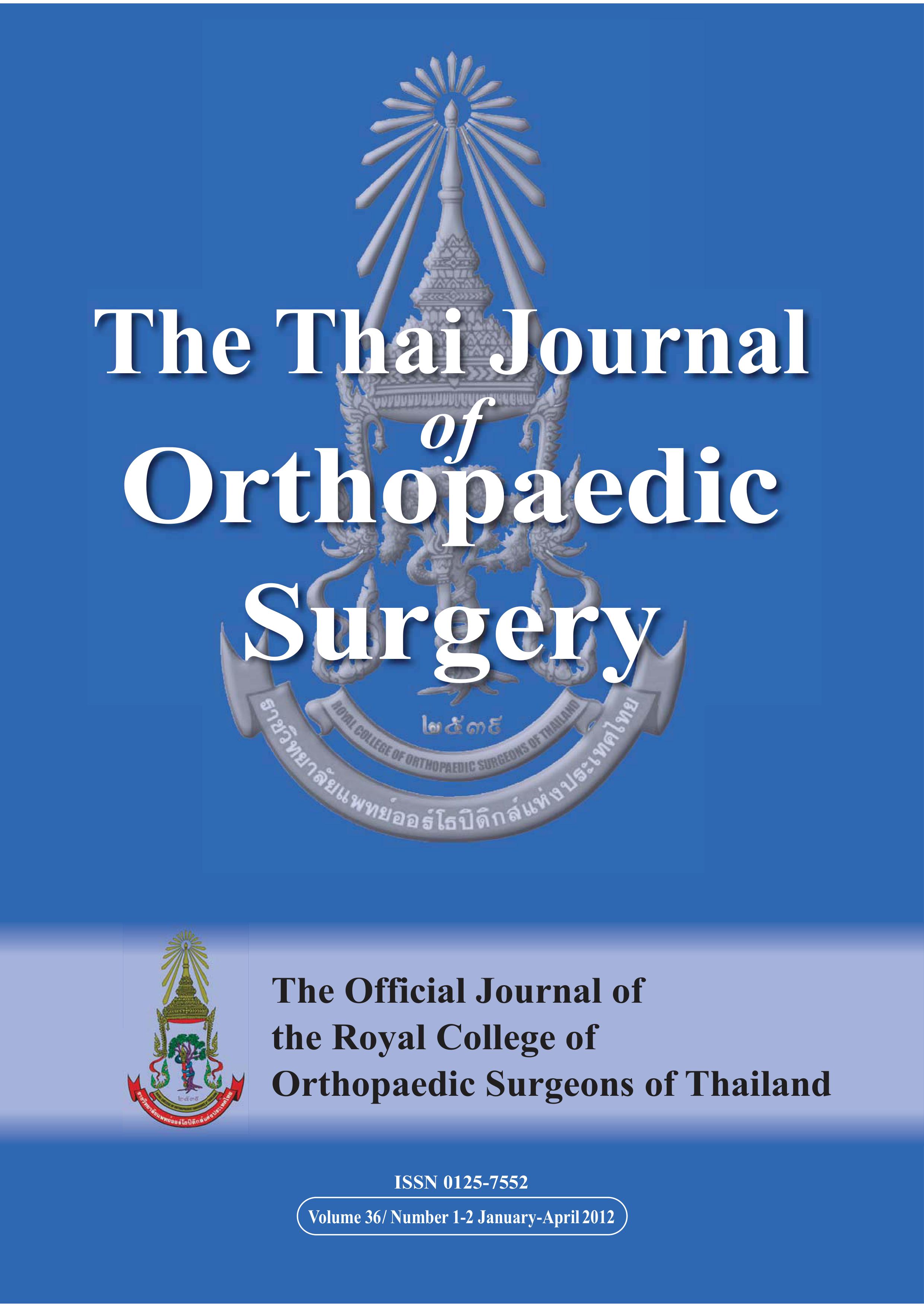Results of the Treatment of Type-C Distal Femoral Fractures using Four Different Implants: Condylar Blade Plate, Dynamic Condylar Screw, Condylar Buttress Plate, and Distal Femoral Locking Plate
Main Article Content
Abstract
Objective: To evaluate clinical results of surgical treatment of type-C distal femoral fracture using four different types of implants.
Material and Method: A retrospective study of 86 patients, all with type-C distal femoral fractures, and who underwent surgery using four different types of implants. The use of condylar blade plate, dynamic condylar screw, condylar buttress plate, or distal femoral locking plate, was evaluated. Following bone union, the functional outcome and the degree of knee flexion were assessed according to Schatzker and Lambert criteria.
Results: Good to excellent functional outcomes of the studied group were found in 72% of the 86 patients. Average knee flexion was 108.6 degrees. Among the four different implants, the functional outcomes were as follows: good to excellent results in 89% of the distal femoral locking plate group, in 78% of the dynamic condylar screw group, in 66% of the condylar blade plate group, and in 50% of the condylar buttress plate group. Knee flexion in patients treated with the distal femoral locking plate was significantly superior to that found in those who underwent condylar buttress plate implant. However, there were no significant differences encountered in other paired comparisons.
Conclusion: Of the four different implants used in surgical treatment of type-C distal femoral fracture, the distal femoral locking plate fixation implant provided the highest percentage of good to excellent functional outcome, and achieved a better degree of knee flexion than the condylar buttress plate. No significant differences were demonstrated in other paired comparisons.
Article Details
References
2. Rademakers MV, Kerkhoffs GM, Sierevelt IN, Raaymakers EL, Marti RK. Intra-articular fractures of the distal femur: a long-term follow-up study of surgically treated patients. J Orthop Trauma 2004; 18: 213-9.
3. Petsatodis G, Chatzisymeon A, Antonarakos P, Givissis P, Papadopoulos P, Christodoulou A. Condylar buttress plate versus fixed angle condylar blade plate versus dynamic condylar screw for supracondylar intra-articular distal femoral fractures. J Orthop Surg 2010; 18(1): 35-8.
4. Sanders R, Swiontkowski M, Rosen H, Helfet D. Double plating of comminuted, unstable fracture of the distal part of the femur. J Bone Joint Surg Am 1991; 73: 314-46.
5. Simonian PT, Thompson GJ, Emley W, Harrington RM, Benirschke SK, Swiontkowski MF. Angulated screw placement in the lateral condylar buttress plate for supracondylar femoral fractures. Injury 1998; 29:101-4.
6. Ostrum RF, Geel C. Indirect reduction and internal fixation of supracondylar femur fracture without bone graft. J Orthop Trauma 1995; 9: 278-84.
7. Bolhofner BR, Carmen B, Clifford P. The results of open reduction and internal fixation of distal femur fracture using a biological reduction technique. J Orthop Trauma 1996; 10(6): 372-7.
8. Krettek C, Schandelmaier P, Miclau T, Bertram R, Holmes W, Tscherne H. Transarticular joint reconstruction and indirect plate osteosynthesis for complex distal supracondylar femoral fractures. Injury 1997; 28(Suppl): 31-41.
9. Kubiak EN, Fulkerson E, Strauss E, Egol KA. The evolution of locked plates. J Bones Joint Surg Am 2006; 88 (Suppl4):189-200.
10. Kregor PJ, Stannard J, Zlowodzki M, Cole PA. Treatment of distal femur fracture using the less invasive stabilization system. J Orthop Trauma 2004; 18: 509-20.
11. Wähnert D, Hoffmeier K, Fröber R, Hofmann GO, Mückley T. Distal femur fractures of the elderly-different treatment options in a biomechanical comparison. Injury 2011; 42: 655-9.
12. Handerson CE, Kuhl LL, Fitzpatrick DC, Marsh JL. Locking plates for distal femur fractures: Is there a problem with fracture healing?. J OrthopTrauma 2011; 25 (Suppl 2): 8-14.
13. Vallier HA, Hennessey TA, Sontich JK, Patterson BM. Failure of LCP condylar plate fixation in the distal part of the femur. J Bone Joint Surg Am 2006; 88: 846-53.
14. Schütz M, Müller M, Regazzoni P, Höntzsch D, Krettek C, Werken CV, et al. Use of the less invasive stabilization system (LISS) in patients with distal femoral (AO 33) fractures: A prospective multicenter study. Arch Orthop Trauma Surg 2005; 102-8.
15. Schatzker J, Lambert DC. Supracondylar fracture of the femur. Clin Orthop 1979; 138: 77-83.
16. Schatzker J, Horne G, Waddell J. The Toronto experience with the supracondylar fracture of the femur, 1966-72. Injury 1974; 6: 113-28.
17. Koval KJ, Hoehl JJ, Kummer FJ, Simon JA. Distal Femoral Fixation: A biomechanical comparison of the standard condylar buttress plate, a locked buttress plate, and the 95-degree blade plate. J Orthop Trauma 1997; 11: 521-4.
18. Sanders R, Regazzoni P, Ruedi TP. Treatment of supracondylar–intracondylar fracture of the femur using the dynamic condylar screw. J Orthop Trauma 1989; 3: 214-22.


